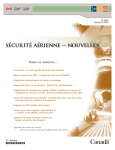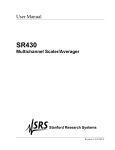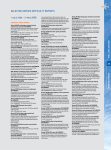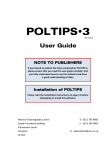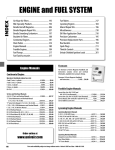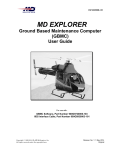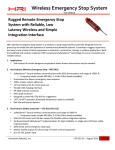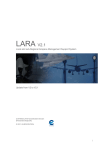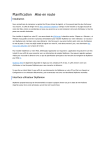Download Here - Civil Aviation Authority
Transcript
The CAA Accident Prevention Leaflet 1 of 2007 issued March Fuel tank vents We frequently remind readers of the hazards of insects and their debris entering and blocking instrument lines through pitot heads and static vents. We hope that pilots not only cover tubes and vents when parked for any length of time, but also inspect them carefully during pre-flight checks. It is however important to check other small holes in the airframe for blockages. The photograph below shows the wing of a US registered AA-5, taken after landing from a trip during which we can only assume the pilot received a nasty scare. The fuel tank seems to have imploded because the air pressure inside the tank became considerably less than the air pressure outside. As the fuel was consumed from inside the tank, sucked out by the engine fuel less than the air pressure outside pump and perhaps the booster pump also, it seems there was no way for air to enter the tank and occupy the space vacated by the consumed fuel. The investigating engineer reports that the vent was clogged with insect debris. As the report states, it is important to periodically check the fuel vents for obstructions, especially when tied down on grass. The daily Check ‘A’ would appear to be a suitable occasion. CONTENTS Fuel tank vents .................... 01 More on fuel flow .................. 07 Here comes the cloud! .......... 14 JAA Medical Certificates ....... 02 Go-around technique ............ 08 April showers ....................... 14 Misfiring? ............................ 02 Helicopter vortex .................. 08 Who’s in charge? ................. 03 Aeroplane accidents 2006 .... 03 Double hush! ....................... 09 Practice approach? .............. 09 Ground hazard? ................... 15 Blown away? ....................... 15 Loose? wiring ...................... 04 Too slow in the climb ............ 10 London Info SSR Code ......... 04 Weight and balance ............. 10 Get some help! .................... 05 Swinging? - dodgy! ............... 11 Fuel pumps ......................... 05 Microlight accidents 2006 ..... 06 SSR trial Controlled Airspace 11 MCASD............................... 12 Fuel caps ............................ 06 MOGAS .............................. 12 Unwanted fuel flow ............... 07 How far can you see? ........... 13 1 JAA Medical Certificates On 1st December 2006, the UK CAA implemented Amendment 5 to JAR-FCL 3 (Medical). This has resulted in some important changes to the period of validity of JAA medical certificates, depending on a pilot’s age and the type of flying operation undertaken. JAA Class One Medical Certificates: • For pilots undertaking single-pilot commercial air transport operations carrying passengers, JAA Class One medical certificates are valid for one year for pilots under the age of 40, and for six months from the age of 40. A “commercial air transport operation” is one which requires an aircraft operator’s certificate (AOC). • For pilots undertaking other commercial operations, JAA Class One medical certificates are valid for one year under the age of 60, and for six months from the age of 60. JAA Class Two Medical Certificates: • For pilots under the age of 40, JAA Class Two medical certificates are now valid for five years. JAA Class Two medical certificates issued to pilots under the age of 40 will not be valid beyond a pilot’s 42nd birthday. • As previously, JAA Class Two medical certificates are valid for two years for pilots between the ages of 40 to 49, and for one year from the age of 50. These validity changes only apply to medical examinations performed after 1st December 2006. There is no retrospective recognition of medical certificates issued prior to this date. Please note that it is the pilot’s responsibility to ensure that his or her own medical certificate is valid for the type of flying operation undertaken. And if the engine starts misfiring? A report in the AAIB’s bulletin 11 of 2006 concerns a fatal accident to a Mooney M20J. Most of the investigation concentrated on maintenance matters, including inconsistencies in the use, provision, and availability of information. However, the accident itself occurred shortly after take-off when the engine appears to have faltered. It seems the aircraft commenced a turn at about 300 feet, during which it appears to have entered the incipient stage of a spin from which it did not recover. We continue to stress in these pages the importance of maintaining control of the aircraft if things go wrong. Decision making is often a comparison of apparent risks, which is made easier if these risks have been compared before the situation arises. A landing ahead, even if the area on which that landing must be made seems totally unsuitable, at least gives the occupants a chance of survival. Losing control in a low turn does not. GASIL Editorial office: Flight Operations Inspectorate (General Aviation), attn GASIL Editor, Safety Regulation Group, Civil Aviation Authority, Aviation House, Gatwick Airport South, West Sussex, RH6 0YR. Telephone (01293) 573225 Fax (01293) 573973 e-mail: [email protected]. Distribution (non-subscribers): FOI(GA) Admin, address and fax as above. Telephone (01293) 573525. Subscriptions: £16 per annum (credit cards accepted), contact FOI(GA) Admin address and fax as above. Telephone (01293) 573525. Photocopying and extracts: Photocopying this leaflet is permitted and short extracts can be published provided the source is duly acknowledged. Content: CAA staff comment and deductions are based on available information. The authenticity of the contents, or the absence of errors and omissions cannot be guaranteed. Nothing in GASIL relieves any pilot, operator or engineer of his/her duty to ascertain and comply with ALL applicable regulations and formal documents. 2 Who’s in charge? We have received yet another report about student pilots arriving at aerodromes during their qualifying cross-country flights with insufficient daylight remaining to complete the flight and return to base. Fortunately, the aerodrome operator advised the pilot to return to base before darkness fell but without completing the intended route. We would again remind instructors of their responsibilities to their students when authorising them to conduct solo flights. Fatal aeroplane accidents 2006 Sadly, again we have to report a number of fatal accidents to GA aeroplanes. There were 7 reported fatal accidents, involving 9 fatalities, to UK registered light aeroplanes during the year. These are included on the graph below. It must be remembered that statistics can be misleading, especially when small numbers are involved. Since none of the investigations have been completed, it would be inappropriate at this stage to draw any conclusions from the information below. However, sadly, loss of control at low speed continues to feature in the initial reports, and we would emphasise the importance of maintaining currency in stall/spin avoidance practice. Neither the list nor the graph includes microlight accidents, listed elsewhere, nor the 4 glider and 1 paraglider accidents which together resulted in a further 6 fatalities. The AAIB’s web site www.aaib.gov.uk contains details of the accidents they investigated, and will include reports on all current investigations as they are concluded. We intend to continue to emphasise particular lessons to be learnt from these accidents in future issues of GASIL. Date Type Reported Circumstances 29 Jun 16 Jul 19 Jul 22 Jul 11 Sep 10 Sep 15 Nov PA23 Slingsby T67 Cessna 150 Yak 52 Cessna 152 Tailwind Stemme S10 Crashed while flying circuits – under investigation Apparently entered a spin during aerobatics – under investigation Under investigation Crashed after manoeuvre following low pass – under investigation – 2 killed Crashed following apparent change in engine noise – under investigation Stalled on approach in Germany, smoke reported in cockpit – under investigation Crashed in hills in New Zealand – under investigation fatal accidents to aeroplanes <5700 kg People killed 45 40 35 30 25 20 15 10 5 3 20 06 20 05 20 04 20 03 20 02 20 01 20 00 19 99 19 98 19 97 19 96 19 95 19 94 19 93 19 92 19 91 19 90 0 Loose? wiring Many pilots carry and use “hand-held” devices such as GPS receivers in their cockpits. In order for such devices to operate as efficiently as possible, peripheral devices such as antennas are often connected by wires to the main equipment. In addition to advice on using GPS as a navigation aid, SafetySense leaflet 25 “Use of GPS” also mentions the need for any “hand-held” equipment to be placed in a safe position, and for pilots to consider any possible interference that such equipment or its peripherals may cause. It advises that any wiring must be routed in a safe manner, and it should not impede emergency exit especially that it should not impede emergency exit from the cockpit. In a special bulletin, the AAIB have described a collision between two gliders. While one pilot was able to abandon his aircraft using a parachute, it appears that the escape of the other pilot may have been impeded by the wiring of his electronic devices he carried in the glider. Reports from the AAIB and foreign accident investigators contain instances of forced landings which have resulted in the pilot having difficulty in making a rapid exit. Whether we fly gliders or powered aircraft, nothing must be allowed to impede exit in an emergency. London Information SSR Code In Issue 3 of 2006 we advised pilots that they were likely to be asked to select a discrete transponder code when receiving a service on one of the ‘London Information’ dedicated Flight Information Service (FIS) frequencies, as detailed in AIC 109/2006 (Yellow 220). The initial results have been encouraging, and it is intended to continue allocating discrete codes to such aircraft. However, the code initially allocated is no longer available for use, and pilots can now expect to be allocated code 1177. A controller at any radarequipped ATS unit who observes that an aircraft displaying this code is approaching their airspace, and they believe likely to enter it without clearance, will be able to contact the London FISO in the knowledge that the aircraft is in radio contact with him. The FISO can then assist with aircraft identification and if necessary transfer the aircraft to the relevant control frequency to resolve the situation quickly and efficiently. As explained in the AIC, it is hoped that this facility will prevent or at least mitigate the consequences of airspace incursions, especially if the pilot selects the altitude facility (Mode C) in addition. When requesting a Flight Information Service from London Information, (as opposed to very short duration information requests, weather reports etc) you are likely to hear for example “GABCD squawk 1177, Flight Information Service”. You should only, of course, select the code when requested by the London FISO. If communication is lost, or as soon as you leave the FIS frequency, you should deselect it (selecting 7000 if appropriate). If 4 an aircraft is identified as requiring radar assistance to prevent an infringement, the radio message is likely to be in the form “GBCDE, at WESTBURY RADAR request - contact WESTBURY RADAR XXX.XXX immediately” The FISOs at London Information do not operate from a radar console and, although they have access to a range of systems providing aeronautical information, they do not have a display of radar-derived aircraft positional data, as can be confirmed from the picture. Importantly therefore, the assignment of this code does not imply the provision of a radar service. It is stressed that no change is being made to the FIS provided by London information and, notwithstanding the use of this SSR code; pilots must remember that FIS is a NONRADAR INFORMATION SERVICE. Get some help! The AAIB have published a report concerning an accident to a Cessna 172. Apparently the pilot had not flown a single-engine piston aircraft for 6 months. He therefore decided to carry out at least 3 practice take-offs and landings, as required by the Air Navigation Order before the passenger whom he intended to carry joined him in the cockpit. During the first landing, the aircraft was observed to pitch up unexpectedly, and it seems the pilot then pushed the nose down in an attempt to prevent the aeroplane from stalling. Shortly afterwards the aircraft touched down heavily on its nosewheel, causing the nose gear to partially collapse and the propeller tips to contact the runway. The report states that the pilot’s most recent experience had been in the simulator of a jet transport aircraft. The accident the pilot himself is responsible report noted that the pilot had expressed concern that he may have experienced a control restriction. Many light aeroplane types require positive control movements when flaring for landing, which a pilot used to power controls may find unusually heavy. With the coming of better flying weather, many pilots may find themselves trying to regain their flying currency. The legal minimum currency requirements for a pilot to carry passengers should in no way be regarded as guaranteeing safety – the pilot himself is responsible for ensuring he is capable of carrying out the flight. If there is any doubt, the assistance of a flight instructor is strongly to be advised. Fuel pumps – know your aircraft We read in a report from the BFU (German AAIB) about a Reims Cessna 172E (Rocket) which suffered a power reduction shortly after take-off, with smoke observed coming from the exhaust. The pilot seems to have made the sensible decision to land in a field ahead, and although the aircraft was destroyed the occupants suffered only minor injuries. normal operation, because, with the engine-driven pump functioning, a fuel-air ratio considerably richer than best power is produced”. The report also notes that the pilot had only a few minutes experience on the aircraft before the accident. Statistics indicate that pilots with low experience on type, as against low overall experience, are more likely to be involved in serious aviation accidents. Lack of familiarity on a new type or variant can catch us all out – we must make sure we really understand the Flight Manual and do our checks with careful reference to it. We should also consider seeking Familiarisation Training from a suitable instructor. LASORS 2007, available from The Stationery Office or free for download from the CAA’s web site www.caa.co.uk/ publications, contains at Section F pages 6 to 9 some very useful advice and guidance to both pilots and instructors on both Differences and Familiarisation Training. The investigation found the auxiliary fuel pump selected to ‘HI’. In this type, as in others, that selection is designed to provide sufficient fuel flow to compensate for a failed engine driven pump, or to purge the system of vapour in extremely hot weather. The Flight Manual for a UK registered example of the type contains the statement that “the auxiliary fuel pump is not to be used while the engine is running during 5 Fatal Microlight Accidents 2006 The reported 3 fatal accidents to UK registered microlight aeroplanes which occurred during 2006 are listed below. A total of 4 persons were killed in these accidents. While the graph shows the actual numbers of fatal accidents in recent years, it would be wrong to draw conclusions with such small numbers involved. The AAIB’s web site www.aaib.gov.uk contains details of the accidents they investigated, and will include reports on all current investigations as they are concluded. Date Aircraft type Reported circumstances 12 Jun Raven X Solo student pilot went missing during general handling flight 6 Aug Letov Sluka Pilot reported control problems – aircraft dived into ground – under investigation 25 Aug Zenair CH 601UL Reportedly crashed and exploded on impact - under investigation – 2 fatalities Fatal accidents to microlights 8 7 6 5 4 3 2 1 0 1989 1990 1991 1992 1993 1994 1995 1996 1997 1998 1999 2000 2001 2002 2003 2004 2005 2006 Fuel caps Although pilots are always responsible for their aircraft, it is undoubtedly a pleasure when keen and friendly ground staff at an aerodrome offer to help with mundane tasks, especially when the weather is less than friendly. Unfortunately, there is always the possibility of confusion when others help. Filler caps are sometimes difficult to open and close, perhaps because the wire securing the cap to the airframe tends to become caught up in the neck. Having filled the tank, the refueller may decide that it would be more helpful to leave the cap insecure so that the pilot can check the contents visually, rather than secure the cap as normal and leave the pilot with the effort of opening it again. It is important that the pilot carries out a final 6 check himself, because on a noisy apron, conversation can be misunderstood. The sight of fuel streaming from a fuel tank as the aircraft takes off is fortunately likely to draw someone’s attention to the problem. However, it seems rather a waste of expensive fuel, not to mention the time spent for the circuit to land and have the cap properly secured! Unwanted fuel flow Several accident reports published recently relate to fuel problems in aeroplanes. That suggests it may be necessary to fuel will flow from the higher to the lower tank remind pilots how important it is to understand the function of the various systems in their aircraft, especially how fuel reaches their engine. The Flight Manual (or Pilot’s Operating Handbook for those without a Flight Manual) describes the systems, and usually gives guidance on normal operating procedures, as well as those recommended in an emergency situation. Two recently reported accidents involved high-wing aeroplanes, although the problem is not confined to those. Operators of aircraft such as most light Cessna types should be aware that if the fuel selector is placed in the ‘LEFT’ or ‘RIGHT’ position, fuel flows to the engine from the selected tank but cannot enter the other tank. However, if the selector is in the ‘BOTH’ position, there is no such restriction. Some low wing aircraft may have similar systems. If the aeroplane is parked on sloping ground, fuel will flow from the higher to the lower tank, sometimes obvious if the tanks are almost full as a “leak” from the vent of the lower tank. If the aeroplane is flown out of balance, the same force which pushes the slip ball to one side will encourage the fuel to flow in the same direction. This may produce a considerable change in relative fuel quantities, resulting in possible handling difficulties and occasionally even running one tank dry unexpectedly. Even if there is no interconnection between tanks, the position of the outlet valve through which the fuel is taken from the tank to the engine may affect the fuel flow. If for example the valve is situated close to the fuselage on a flat bottomed tank, unbalanced flight may push the fuel towards the wing tip and uncover the outlet valve even when an apparently sufficient quantity of fuel remains in the tank. Unbalanced flight is perhaps more common than many may think. For example, passengers often wish to take photographs of objects on the ground, and the pilot usually attempts to make their photography as easy for them as possible. Because of the construction features of light aeroplanes, in order to keep the ‘target’ steady in the passenger’s viewfinder, the pilot must yaw the aeroplane, either outwards on a low wing aircraft or inwards on a high wing aircraft. Unbalanced flight when close to the unusable fuel level in a tank from which the engine is drawing fuel is likely to result in at best rough running, and possibly engine stoppage. When close to the ground, or at any time in a diesel-engined aircraft, it is unlikely that the engine will re-start in time to climb away. More on fuel flow Other accidents have occurred to aeroplanes where fuel cannot be transferred between tanks, and the pilot has used all the fuel out of one tank. If air is sucked from an empty tank into the engine, it will take time for fuel from a hurriedly selected alternative tank to reach the engine and allow it to re-start. It is vital that before a pilot descends towards the aerodrome, he should ensure he has selected the tank which contains most fuel. Of course, if the fuel has been used equally during the flight, 7 such problems are unlikely to occur. There are several ways of organising fuel use to achieve this, but a simple one was suggested to us some time ago. During a routine top of climb, cruise or navigation check, the pilot should look at his watch or clock. While the minute hand is pointing to the right (first half of the hour), he should have the right tank selected, and when the minute hand points to the left, select the left tank. Of course, those pilots who use a digital timepiece will need to develop their own system! Go-around technique An accident reported in the AAIB’s bulletin 11 of 2006 involved a Rockwell Commander whose pilot decided to fly a go-around from a bounced landing, which is normally considered to be the safest course of action. In this case, however, it seems that as he raised the flaps, the aircraft sank back onto the runway and the nosewheel collapsed. As demonstrated during flying training, the final stage of flap retraction often results in a loss of lift. It is therefore advisable for the pilot to retract flap in two stages during a go-around. However, as in many aeroplane types, the flap selector on this aircraft is an electrical switch which when selected to UP continues to move the flaps fully upwards unless the pilot deliberately resets the selector switch to NEUTRAL. It is possible for a pilot to find the trim changes from the flap retraction and the increased power applied during the goaround occupying his full attention, as it seems to have been in this case. It is important that a pilot regularly practises all necessary handling techniques in the aircraft he is flying to ensure he can use them instinctively when they are required. In the case of an aircraft with major trim changes during the go-around, practice at a safe height might be considered advisable. However, it is generally recognised that most problems on landing are a consequence of a poor approach. We would recommend that if the pilot knows he will be faced with awkward trim changes on a goaround, it makes it particularly important that he recognises an incorrect approach early, and commences the go-around with plenty of height to spare. Helicopter vortex We recently received a report from the pilot of a light aeroplane. While flying cross-country, he had seen a large military helicopter which he assessed was below him and passing just in front of his aeroplane. He kept the helicopter in sight, passed behind the helicopter and above it. As he crossed behind the helicopter, he experienced what he assessed as very severe turbulence. This surprised him as he was expecting strong wake turbulence in the area below the helicopter’s flight path, but not above it. A helicopter’s rotors move a considerable amount of air to achieve the necessary lift. The heavier the helicopter, the greater the amount of disturbed air. The air moved downwards by the rotor provides that lift, and is the disturbed air extends upwards obvious threat. However, more air is drawn into the area from which the downwash began, and a complete flow pattern, similar to that produced in convective thermal currents is formed. The disturbed air extends upwards from the rotor disc as well as downwards, and may remain in place for some time after the helicopter has passed. While the disturbed air does not normally extend vertically over any great distance, and should slowly sink, it is advisable to not only avoid passing below, but to pass well above, the immediate wake of a helicopter. 500 feet above probably provides a safe margin in most cases, but in the case of a large helicopter more might be advisable. 8 Double hush! The New Zealand CAA’s safety magazine ‘Vector’ includes a report of an engine failure in a PA34 during a training flight caused by the failure of the mechanical fuel pump. Unfortunately, this failure occurred as the student pilot was carrying out the failure drills on the other engine on which the instructor had just simulated a failure! It proved possible to restore power to the genuinely failed engine by selecting the electric fuel pump ON, and the aircraft was landed using power from both engines. However, this incident should provide a salutary lesson to all instructors that xxx’s law is likely to catch us out at just the time we don’t want it to! Can I do a practice approach? In a report from the BFU (German AAIB) we read of a PA28 pilot who had planned a night VFR cross-country flight, which is permitted in Germany. The Air Traffic Control service at his destination closed before he took off, but the aerodrome continued to provide a Flight Information Service for VFR traffic until just after he was due to arrive. The aerodrome was equipped with an Instrument Landing System (ILS), but the pilot held no instrument qualification. As the Cherokee approached its destination, the FISO reported a visibility of 2000 metres under a 400 foot cloudbase. The pilot asked if he could make a “simulated ILS” approach, for which the FISO gave his agreement. A few minutes later the FISO heard the aircraft’s callsign, then nothing more was heard from it despite repeated calls. The wreckage was found later in a field 3 kilometres from the aerodrome and close to the runway approach path. Evidence suggested that the pilot had attempted to join the ILS localiser from an angle of 90 degrees. Having flown through the the pilot held no instrument qualification centreline, the aircraft descended below the glidepath. According to a witness, it appeared out of the mist at very low height before crashing into the field and exploding. 9 While one might criticise any decision to fly when the forecast suggests VFR flight to be inadvisable, we should note that several fatal accidents seem to occur when a pilot has completed the majority of his journey before encountering bad weather. It seems that once a person has ‘invested’ considerable time and effort in the flight, he seems more reluctant to throw that ‘investment’ away by diverting or returning to his starting point. If a pilot discovers that an approach aid is still switched on outside its operating hours, it may be very tempting to use it for guidance. However, the necessary safety procedures will no be longer in place, and it cannot be relied on, even if the pilot is qualified to use that aid under normal circumstances and current in doing so. Too slow in the climb . . . The AAIB have published a report in their bulletin 12 of 2006 about an accident which occurred to a PA-22 shortly after take-off. As with many of their investigations, the report is worth reading in full, and may be downloaded from the AAIB’s web site http://www.aaib.gov.uk/ publications/index.cfm. It was a warm summer’s day with little wind, and the aircraft was close to its maximum authorised take-off weight. Shortly after take-off, the pilot apparently realised that he had selected an inappropriately high nose attitude and the airspeed was not rising as it should have been. Although he knew that the solution to the problem was to lower the nose, the high nose attitude seems to have caused him a further problem, in that he could not see his position relative to the runway or the relatively high hedge at the end of it. Since he was concerned that lowering the nose might have brought him into contact with the hedge, he opted to continue the climb with the high nose attitude until he had reached he opted to continue the climb with the high nose attitude a safe height. Whether as a result of turbulence from the nearby trees or just a reduction in airspeed during the climb, the aircraft seems to have stalled in the climb. Many pilots who have practised stall recoveries from a high nose attitude with full power applied have noted that a wing drop seems more likely and more rapid than when stalling from level flight. Certainly, in this case, the wing did drop and the aircraft hit the ground with its wing tip before somersaulting and coming to rest inverted. Similar accidents have resulted in fatalities, and it is indeed fortunate that although all the occupants were injured, none of the injuries were classified as serious. The report draws attention to the differences in behaviour between an aeroplane at high all up weight and one which is normally operated at a lower weight, and reminds pilots to ensure they have accelerated sufficiently before selecting the climb attitude after take-off. Airspeed is vital close to the ground, and when power available is fixed, speed is controlled by the pitch attitude. Better to fly into a hedge under control than spin in, Weight and balance Recent AAIB bulletins have contained several reports of accidents in which the aircraft were flown outside the authorised limits of their weight and/or centre of gravity (C of G) position. Some of these were fatal. The CAA requires pilots to carry out accurate weight and balance calculations, and to avoid flight outside the limits, not because we want to increase a pilot’s work load, but to maintain the aircraft in an airworthy condition. If an aircraft is flown overweight, it will not perform as the Flight Manual would lead the pilot to expect. Take-off distances will be increased, rates of climb reduced, and rates of descent increased when gliding. Stalling speed will also increase. limits are set by the manufacturer The aircraft’s centre of gravity limits are set by the manufacturer because if flown outside these limits he considers the aircraft would be difficult for an average pilot to control safely. The further aft the C of G position, the more 10 unstable an aeroplane will be in pitch and yaw, because the tailplane and fin moments have been reduced. However, an aft C of G will also reduce the effects of elevator and rudder movement, and that reduction in control effectiveness, together with the consequent change in inertial forces, is likely to make spin recovery very difficult. An aeroplane whose Certificate of Airworthiness or Permit to Fly prohibits intentional spinning is likely to be difficult to recover from a spin even when loaded within permitted limits. Swinging?- dodgy! While accepting that for certain aircraft it is the norm, we frequently draw attention to the potential hazards of attempting to start an aeroplane engine by hand swinging the propeller. Because there are many facets to handswinging, it is very difficult to provide generic advice, which is why we emphasise the importance of proper instruction from a qualified person before attempting the task oneself. One point to remember is that swinging should only be attempted if it is permitted by the Flight Manual. As accident reports all too frequently remind us, if the pilot or otherwise qualified person is not sitting in the cockpit with direct control over the throttle and brakes (if fitted), the aircraft may move forward out of control. However, a possibly greater danger is posed by the ignition system of virtually all light aeroplanes. Because a broken the engine may spark into life wire in the system will prevent the magneto current running safely to earth when not required, it is always possible that the engine may spark into life at any time if the propeller starts to move (or if an ignition switch is moved). When touching a propeller, or moving any part of one’s body within it’s rotation disc, you must always expect that to happen. It seems from reports we have recently received that some pilots have been attempting to start aircraft which are not usually hand-swung, and which are very awkward to swing safely. One possible reason for this unusual action may be a flat battery; however, we remind pilots that it takes a long time for an engine to re-charge a battery and in the event of an engine or alternator problem in flight all electrical power is likely to be lost very rapidly. Much better to delay the flight and remove the battery for re-charging on the ground. SSR trial around Controlled Airspace As detailed in AIC 4 of 2007 (Yellow 228), a one year trial has recently been introduced in airspace around the Luton and Stansted Control Areas with the aim of reducing the likelihood of aircraft inadvertently entering controlled airspace while attempting to transit around it. Pilots of aircraft flying in the vicinity of these Control Areas but not intending to enter it, or to ask for any air traffic service from the controlling authority (Luton Radar or Essex Radar), may choose to listen out on the applicable controlling frequencies as published on current CAA charts. To indicate that they are so listening, they may at the same time select code 0013 on their transponder with Mode C (altitude information) if fitted. If a controller then suspects that the squawking aircraft is likely to enter the controlled airspace, he knows that the pilot is listening out on his frequency and can attempt to contact him to obtain flight details and perhaps guide him away from controlled traffic. The use of Mode C is a most important part of not only this trial, but of every attempt to minimise any collision risk resulting from an uncontrolled aircraft straying into 11 controlled airspace. Not only can the controller direct his controlled traffic around the straying aircraft, but suitably equipped aircraft will be warned of its presence, and in some cases given resolution advice automatically, by their airborne collision avoidance systems (ACAS). If your aircraft is fitted with an altitude reporting facility (Mode C) on its transponder, the pilot should automatically select it (ALT) whenever his transponder is switched ON. Indeed, that transponder should be switched on (and therefore to ALT) at all times in UK airspace unless an Air Traffic Controller requests otherwise. MCASD As announced in the last issue, the Defence Aviation Safety Centre have arranged a military/civil aviation safety day (MCASD) at the Army’s helicopter base at Wattisham in Suffolk on Tuesday 22nd May 2007. Pilots and others involved in general aviation are invited to visit Wattisham Station to discuss local and general safety matters affecting flight in the lower airspace with military operators and air traffic controllers. A certain number of places may still be available for aircraft to fly in, and registration forms for these and for those wishing to attend by car will be available on the CAA’s web site www.caa.co.uk/ga through ‘information’. Attendance at the event is free, although aircraft flying in will be subject to a small facility charge. Those without internet access should write, stating the number of places required and whether they wish to apply for a fly-in place if available to : of vapour lock, the alcohol can corrode parts made of rubber and other materials, which in turn may cause deterioration and malfunction of the fuel system, or fuel leakage with the associated risk of fire. It can also increase the likelihood of any water in the fuel separating out at low temperatures, with the microlight aircraft, operators should consider the possible consequences of using fuel containing alcohol. Project Officer MCASD 2007 Defence Aviation Safety Centre PO Box 333 RAF Bentley Priory Stanmore Middlesex HA7 3YN MOGAS The current arrangements in both the UK and the US that allow aircraft (other than microlights) to use MOGAS stipulate that no alcohol is present in the fuel. The specification for motor gasoline has always permitted the presence of a small amount of alcohol, although traditionally manufacturers have not included any in their fuel for sale to the motoring public. However, as EASA has advised in a Safety Information Notice (SIN) a recent EC Directive has made it likely that motor gasoline will in future be supplied containing an increasing amount of alcohol. It is therefore particularly important to check before using MOGAS that the fuel does not contain alcohol. Some of the likely effects of alcohol on an aircraft engine are described in SafetySense leaflet 4, “Use of motor gasoline in aircraft” available in LASORS and for free download from the CAA web site www.caa.co.uk/ publications through “general aviation”. Other likely effects are described in the EASA SIN, and also in a Special Airworthiness Information Bulletin from the FAA. Apart from an increased likelihood alcohol can corrode consequent increased risk of carburettor icing and of water being drawn into the engine instead of fuel. Finally, because the presence of alcohol reduces the energy content of the fuel, the aircraft will suffer a reduction in range. For these reasons, all current exemptions allowing aircraft to use motor gasoline contained in Airworthiness Notice 98C require that the fuel be free from alcohol. Microlight aircraft are covered by Airworthiness Notice 98B, and although alcohol is not prohibited in MOGAS used by applicable 12 SafetySense leaflet 4 includes a suitable test for the presence of alcohol: 1) Obtain a clear tube, (such as a fuel sampler), and mark a line on it about 10% from the bottom. 2) Add water to the tube until it comes to the line. Fill the tube with the fuel sample until it is near the top. 3) Shake vigorously for 1015 seconds, then let it settle. 4) If the meniscus dividing the fuel from the water is on the line, the fuel sample is alcohol free. 5) If it is above the line (because the alcohol has mixed with the water) alcohol is present and the fuel must not be used in an aircraft. How far can you see? The AAIB’s recent special bulletin on a fatal glider collision reports that the aircraft were soaring at about 1500 feet near to the base of cloud when the surviving pilot suddenly saw the other glider very close to him. He attempted to avoid the collision but the aircraft collided almost head-on. Glider pilots wear parachutes when flying, partly because they understand that their operations in close proximity to each other are more likely to result in a collision than those of most other aircraft. However, height and time are needed, first to escape from the aircraft and then for the parachute to open after operation. Few pilots of other aircraft wear parachutes. protection to other IFR aircraft cruising above 3000 feet in the UK, and may be found travelling in any direction at any altitude. Power pilots might consider that the greatest collision risk to a glider would occur during thermal soaring, when the aircraft are circling close together. However, an equally great risk results from the fact that in order to find good soaring conditions, gliders frequently fly close to cloud, and often under instrument flight rules (IFR). Because they are always climbing or descending, they do not follow the quadrantal rules which provide an element of Pilots of other aircraft who elect to fly near cloud should bear this fact in mind. Although PPL holders are restricted to a flight visibility of 3000 metres and remaining in sight of the surface, the restrictions do not prevent pilots from flying very close to cloud, and do not apply to those with IMC ratings. Think carefully before flying close to cloud. Could there be another aircraft just about to pop out of it? 13 Here comes the cloud! – so what? We may even be able to reach our destination just ahead of the worst of the weather and clear of cloud. Accident and incident reports, not to mention “I learnt about flying from that” telephone calls or bar stories, often involve unexpected weather deteriorations. While often we point out that the probability of these deteriorations had been mentioned in aviation forecasts, it is a fact that pilots do sometimes encounter unexpected bad weather. By far the most important thing when we encounter bad weather is to recognise it for what it is early enough to do something sensible about it. We must be constantly watching the horizon (and not just in front of us) to look for any grey patches or any reduction in visibility which might indicate cloud or precipitation along our intended flight path. Hopefully, we will have already thought about possible actions in the event of bad weather and preplanned a return to base or diversion if we cannot get through to our destination safely. It may be possible to avoid cloud by descending, providing we can remain safely above all obstacles. However, if we do find ourselves flying close to cloud, there are likely to be other hazards apart from the dangers inherent in losing visual references. Apart from the increased collision risk posed by another aircraft perhaps on the other side of a cloud or precipitation patch, the humidity of the air close to cloud is certain to be high. The risk of serious icing in the carburettor will be much greater. Increase the frequency and duration of your recognise it for what it is routine carburettor heat checks, and unless you need full power from your engine consider selecting full carburettor heat before flying close to any cloud or precipitation. April Showers While ‘global warming’ may affect the traditionally expected seasonal changes to the weather over the UK, we will undoubtedly encounter showery conditions at some time during the Spring, and during the other seasons as well. Most pilots will attempt to avoid flight in such shower clouds, but should remember that if they choose to fly below one, they will experience not only considerably reduced flight visibility (almost zero if it is cold enough for snow), but also a lower cloudbase in the shower than under a cloud which is producing no precipitation. Even if we have avoided the shower itself, the low altitude wind direction and strength is likely to vary in the vicinity. It must also be remembered that any water which has fallen from the sky will affect the surface of the ground beneath. If rain has fallen on our intended landing site, our landing distance will be increased, as explained in SafetySense leaflet 7, “aeroplane performance”. This applies even on a hard surface, but to a much greater extent on a grass one, especially if the shower has fallen on short grass over basically firm ground, as the pilot of a Cessna 182 appears to have found to his cost, according to a report in the AAIB’s bulletin 11 of 2006. 14 A less obvious ground hazard? In the AAIB’s bulletin 11 of 2006, we read that the pilot of a Van’s RV-6A had discovered that the aircraft battery was flat when he arrived at the aerodrome. He apparently decided to use jump leads from his vehicle connected to the aircraft battery terminals to provide power to start the aircraft engine. It seems that once the engine had started, his head came into contact with the throttle while he was disconnecting the jump leads. The aircraft moved forwards, breaking the tie-down from the left wing and colliding with his vehicle, damaging both the vehicle bumper and the aircraft propeller. As the pilot states in his report, it would have been safer to remove the battery and charge it on a battery charger. Indeed, we have advised exactly that in previous issues, but usually to reduce the risk of damage from the battery, not from the power supply! Blown away? As the number of aircraft on GA aerodromes has increased, so has the demand for parking and hangar space. In many cases, taxiways have become lined with aircraft or hangars almost all the way along, and this applies not only in the South of England. We often remind pilots of the importance of carrying out comprehensive pre-flight checks. These invariably include power checks before lining up, which in turn involve increasing the engine and propeller or rotor rpm. The consequent slipstream, downwash or jet efflux can have considerable effect on aircraft or other objects which lie in its path, and although it is unusual for an aircraft to be actually blown over by the slipstream from a GA aircraft, damage has certainly occurred, either as a direct result or as a consequence of an object being blown against a parked aircraft. Before carrying out our power checks (or applying high power to clear soft ground), we need to be aware of what might be in the path of our jet, rotor or propeller wash, remembering that wind will also affect it. Keep it away from parked aircraft or open hangar doors, and watch out for any aircraft which might be about to taxi behind you. Word for the Spring ... and Summer ... and all time “Maintain thy airspeed at all times, lest the ground rise up and smite thee!” 15 Piper PA24 Comanche – Control Yoke Failure During the landing flare, the control column yoke failed and detached from the actuating tube. Fortunately the aircraft suffered no further damage during the landing. The engineering investigation found the item to be cracked. A replacement part was inspected prior to installation and was also cracked (see the attached photographs). The Piper Comanche Service Manual does require a visual inspection of the control wheels and column at 100 flight hours. The concern is that the area is not readily accessible for visual inspections with the protective finish in place. Engineers are recommended to pay attention to this area during maintenance and if similar cracks are evident, report their findings to the Type Certificate Holder and the CAA via the MOR system. CONTENTS Piper PA24 Comanche ......... 16 It’ll be OK! ........................... 20 EASA aircraft ....................... 17 FAA Bi-weekly Lists ............. 20 Owners, Operators, Maint ..... 17 Letters to Owners/Operators . 21 Airworthiness Directives ........ 18 Mis-selection ....................... 19 Mandatory Permit Directives . 21 FAA Maintenance Alerts ....... 21 16 EASA aircraft (not applicable to Annex II aircraft) On 28th September 2008 the European Aviation Safety Agency (EASA) will impose some significant changes upon the way UK aircraft are kept airworthy. Effects on aircraft with EASA Certificates of Airworthiness will be seen as early as September this year. The current UK continuing airworthiness system relies upon the periodic renewal of Certificates of Airworthiness, each renewal being preceded by an application, a technical review and usually a fee. Once the CAA receives confirmation that airworthiness has been assured or restored, it then issues a new Certificate of Airworthiness for the next period, traditionally for 3 years. The new European system dispenses with the need to renew Certificates of Airworthiness by rendering them non-expiring but will introduce a new Airworthiness Review Certificate, a new type of approved organisation to manage continuing airworthiness and two alternative control regimes running in parallel. The Airworthiness Review Certificate (ARC) is valid for only one year, but can be extended. A new category of approved organisation is created; the Continuing Airworthiness Management Organisation (CAMO), which reviews and controls aircraft airworthiness. A CAMO can extend or re-issue ARCs itself. One control regime allows official customers of a CAMO to have their ARCs extended or reissued entirely by the Management Organisation. Under this regime there will be no need to make any applications to the CAA. The other regime allows aircraft owners to manage their own continuing airworthiness. However, each year they will still require an airworthiness review from a CAMO. They must then apply to the CAA directly for the certificate. The charge currently made at renewal of a Certificate of Airworthiness funds all the CAA activity which takes place during its period of validity. That activity is vital to safety and EASA will not be involved, so after an industry consultation the CAA is proposing to charge owners and operators for the issue of ARCs in order to continue with this activity. If a private owner wishes to manage his or her own maintenance, then a fee will have to accompany the application for a new ARC each year, as at present. However, those who place their aircraft under the care of a CAMO can have their ARC extended twice, thus a new ARC is only required every 3 years. And even then the CAMO can do this without asking the CAA. The price of a CAA annual ARC will be similar to that currently charged for an annual C of A renewal. A professionally managed or “Controlled Environment” ARC will be noticeably cheaper and a full review is only required every 3 years. As before, the fees are set on aircraft weight. When a CAMO is managing continuing airworthiness they will send data to the CAA each time they extend or issue an ARC. The CAA will then send it a bill once a quarter, producing a cheaper and simpler system than the existing one. The CAA would like to see as many aircraft as possible have their airworthiness managed professionally, so is putting a lot of energy into ensuring that there are enough CAMOs to go around. This includes giving full recognition to existing approved organisations to significantly reduce the paperwork and cost of acquiring the new approvals. In order to get the new system ready, the CAA will replace all expiring Certificates of Airworthiness with non-expiring ones from 28th September this year, and will issue the first ARC itself. Owners who wish to take full advantage of the CAMO facility should make suitable arrangements as soon as possible, and certainly before the non-expiring C of A is issued. For the attention of Owners, Operators and Maintainers The Civil Aviation Authority is now accepting applications for approvals under Part M Subpart G, and Part M Subpart F, in order to meet new EASA regulations by 28 September 2008. To provide assistance to the GA sector for the transition to Part M, the CAA is prepared, where time and resources permit, to provide guidance and briefings to groups of interested parties. For further enquiries please contact the CAA via: [email protected] 17 Airworthiness Directives CAP 747 - “Mandatory Requirements for Airworthiness” - is the primary UK reference for Airworthiness Directives (ADs) and other mandatory airworthiness information applicable to aircraft registered in the UK. CAP 747 contains, in full, all new ADs for UK products as approved by the European Aviation Safety Agency (EASA), together with ADs issued by EASA for products designed outside the EU. CAP 747 also contains the UK Airworthiness Directives and import requirements that continue to be required for UK registered aircraft in addition to EASA standards. These measures have been notified under Article 10.1 of Regulation (EC) No.1592/2002. CAP 473 and CAP 474 have now been withdrawn and foreign ADs should now be obtained directly from the States of Design, many of whose web sites are listed on the CAA’s own web site www.caa.co.uk through ‘srg’ and ‘airworthiness’. The final issue of CAP 476 remains applicable as it specifies UK mandatory requirements for UK products issued before 28th September 2004 and adopted by EASA as the European standard. Any deletions from CAP 476 are notified in CAP 747. CAPs 476 and 747 are available free of charge from the CAA Web Site: www.caa.co.uk/publications. Paper copy of CAP 747 may be purchased (including amendment service) from TSO: TSO PO Box 29 Norwich NR3 1GN Telephone: 0870 600 5522 Fax: 0870 600 5533 E-mail: [email protected] Website: www.tso.co.uk/bookshop EASA approved foreign-issued Airworthiness Directives are available, as are bi-weekly summaries of recent EASA ADs, through EASA’s web site www.easa.eu, and the most recent EASA approved airworthiness directives may be accessed through a specific part of that site http://ad.easa.eu.int/ We are aware that the following ADs have been recently issued, however this list is certainly NOT exhaustive and must not be relied on. AD Number Applicability Description EASA 2006-0373R1-E Stemme 10AP-F, 10AP-V, 11AP-V propellers Blade follower EASA 2007-0001R1-E Solo Kleinmotoren 2 625 01, 2 625 02 engines Propeller slip clutch EASA 2007-0014 Apex CAP 10B Press to talk wiring through flight controls EASA 2007-0015 Apex CAP 10B Wing main spar EASA 2007-0016 Dassault Falcon 2000 Engine cowlings EASA 2005-0028R1 Apex HR100, R1180 series Wing spar EASA 2007-0017 Apex R 3000 series Wing internal structure EASA 2007-0025 Rotax 912 & 914 engines Crankcase EASA 2007-0027 Vulcanair (ex Partenavia) P68 Wing safe fatigue limits EASA 2007-0028 RUAG (ex Dornier) 228 Fuselage frame 19 CASA AD GA8/5 amdt1 Gippsland GA8 Horizontal stabiliser EASA 2007-0039E Shorts SD-3 Engine & landing gear control cables EASA 2007-0042 Schleicher ASW 28-18E RRPM sensor & fuel pump attachment plates EASA 2007-0032 Dassault Falcon 2000Ex, 900EX Avionics software EASA 2007-0034 EADS Socata TB9, TB10, TB200 Engine & nose gear life limits 18 Mis-selection In the AAIB’s bulletin 1 of 2007 we read of a PA-23 pilot who mistakenly selected undercarriage up while stationary. Unfortunately, the safety device which should have prevented the gear actually unlocking was faulty, and the left undercarriage leg collapsed causing damage to the wing, gear and flap. The Apache has an antiretraction valve whose operating rod had apparently seized in the “flight” position shown in figure 1 below. As the investigation pointed out, the valve should be inspected at every 50 hour inspection. Many pilots of older aircraft appreciate the increased likelihood of older aircraft parts seizing or failing, and having learnt about their undercarriage systems, have developed the habit of inspecting the visible 19 parts of their undercarriage carefully during their pre-flight inspections. However, this particular part is in an extremely awkward place for such a visual inspection, as seen in the final photograph which required a flash gun, and even the most conscientious pilot is unlikely to be able to identify that the microswitch arm is in the extended position and its return spring is at full stretch . It’ll be OK! The AAIB’s bulletin 11 of 2006 includes a report on an accident to a Skyranger microlight whose Rotax 912-UL engine failed shortly after take-off. The aircraft was damaged in the ensuing forced landing. On the previous day, the pilot owner had performed an oil and filter change on the aircraft, using a filter obtained from another owner who stated it was suitable for use in his own engine. The filter was slightly longer than the original one, and the pilot had difficulty installing it. In fact, it seems the filter threads had stripped during the attempt to install it. The UK distributor for Rotax apparently advises that only one type of filter is approved for use in that particular engine, as illustrated below. The one the pilot had installed was not that approved type. Only ever use the correct, approved, parts in an aircraft. If an owner, or even possibly an engineer, cannot obtain the correct part as quickly as desired, it is always tempting to fit something which appears to be suitable rather than wait until the correct part can arrive. This accident will hopefully remind us all that such a practice can have very serious consequences. It may also remind us of the dangers of trusting what someone else tells us! FAA Bi-Weekly Lists Many UK registered aircraft are US designed. Others contain engines or other parts produced in the USA, and therefore subject to FAA regulation. It is the owner’s responsibility to ensure that his aircraft and component parts comply with all regulations including Airworthiness Directives. For that reason GASIL continues to draw attention to the FAA Bi-weekly listings of Airworthiness Directives. We are aware that the following have appeared in these listings since the last GASIL publication date, but owners should regularly check the web sites of the Regulatory Authorities for whatever State produced their aircraft and all its equipment. FAA ADs, including the Bi-weekly listings for small aircraft, are available on the internet through www.faa.gov Under “Aircraft” select “Advisories and Guidance”, “Aircraft Safety Alerts” and “Airworthiness Directives”. Biweekly 2006-25 2006-25 AD 2006-24-07 2006-24-11 Aircraft/equipment type Hartzell & McCauley Propellers Raytheon Beech 1900, 1900C, 1900D Item Previous inspections and repairs Wing rear spar lower caps 2006-26 2006-26 2007-01 2006-23-02 2006-25-08 2006-26-08 Raytheon Beech C90A, B200 & B300 series Columbia Lancair LC41-550FG, 42-550FG Raytheon 390 Flight controls De-icing system Hydraulic pump outlet tube 20 Letters to Owners/Operators The following Letters to Owners/Operators (LTOs) have recently been issued by the CAA. An LTO does not in itself contain any mandatory requirements, but is intended to pass information. It may contain, for example, an item of significant airworthiness information received from a foreign Aviation Authority. LTOs are listed with Airworthiness Directives on the CAA website www.caa.co.uk, through ‘srg’ and ‘airworthiness’. LTO 2967 Hot air balloons subject to EC (EASA) regulations Certificates of airworthiness LTO 2851 Rev A LTO 2882 Rev A Cessna/Reims Cessna aircraft below 5700 kg Hartzell aluminium 2-bladed propellers fitted to Lycoming 360 series NARCO AT150 transponder Supplementary inspection documents LTO 2972 Withdrawal – revised AD issued Compliance with FAA AD 2004-08-16 Mandatory Permit Directives The following Mandatory Permit Directive (MPD) for rotary wing aircraft has recently been issued by the CAA, and will be published in the next amendment to CAP 661, which contains all previously issued current MPDs and is available for free download from the CAA’s web site www.caa.co.uk/publications . Compliance is mandatory for applicable aircraft operating on a UK CAA Permit to Fly. MPDs are listed with Airworthiness Directives on the CAA website www.caa.co.uk, through ‘srg’ and ‘airworthiness’ 2006-014 P&M Aviation CT2K microlights Flap ‘UP’ limit cables FAA Maintenance Alerts Since the last issue, the following maintenance alerts have been published by the FAA. The full text of each is available on the internet on their web site www.faa.gov Under “Aircraft” select “Advisories and Guidance”, and “Aircraft Safety Alerts” and “Aircraft Maintenance Alerts”. which are divided into monthly bulletins. Those without access to the internet can have a copy of the item which interests them by sending a stamped, self-addressed, envelope to: Flight Operations Inspectorate, General Aviation Admin Section, Aviation House, Gatwick Airport South, West Sussex RH6. Aircraft/equipment type Bellanca 7GCBC Item Wing spar crack Cessna 172R Cessna 182 Cessna 206, 207, 210 series Cessna 560 Cessna series Oil pressure sensor failed - windscreen splashed with oil in flight Broken nosegear downlock pins Water retained in elevator trim tabs Cabin entry frame cracked at aft step attachment Plastic control wheels cracking and failing Cessna T210M Continental TSIO 520NB engine Continental TSIO-520-M engine Dassault 20 Diamond DA40F Cabin step cable interfered with nose gear linkage Cylinder head cracks 5 out of 6 ECI cylinders found cracked Landing gear uplock switch inoperative Alternator output wiring failed - total electrics failure Diamond DA40FP Gulfstream GIV Gulfstream IV Lancair LC41 Lear 55 Fuel filler caps loose allowing water ingress - 3 instances Fuel shutoff solenoid valve missing alignment pin Thrust reverser actuator defective - unlock light in flight Oil pressure union cracked through Outboard gear door hinge broke - door fell off in flight Learjet 35 Lycoming IO360-A3B6D engine Mooney M20C Piaggio P-180 Piper PA25 Air Data Computer failed in flight (3 instances) Loose bushing in accessory drive Nose gear assembly tubes broken - collapsed on landing Rudder trim tab lower contol rod attach lug found broken Argentinian AD on horizontal stabilizer inspections Piper PA44-180 Rockwell 112A Nose gear drag link bolt failed Roll servo incorrectly rigged 21 Overspeed? According to the New Zealand CAA, a report by the TAIC (the New Zealand AAIB) into a fatal Bell UH-1B accident in 2004 has concluded that the accident was caused by a fatigue failure of a tension-torsion strap on the main rotor hub. While the report, as in the case of many fatal accidents, could not be certain about the reason for the apparently accelerated rate of fatigue, it concluded that it was probably the result of an unreported previous rotor overspeed event. It is a natural but unfortunate fact that pilots may be tempted to ignore things like overstresses or overspeeds if they appear to have caused no obvious ill effects. It is possible that the thought of an apparently undamaged aircraft being out of commission until an inspection can be completed may override the knowledge that any operation of an aircraft or its parts beyond the published limits is likely to have weakened the structure in some way. However, unless a qualified engineer makes that inspection and is able to determine if and how seriously any damage may have occurred, the aircraft should not be flown. One fatal consequential failure is too many! Unmanned aerial vehicle The New Zealand CAA’s safety magazine ‘Vector’ contains a short report about an accident to a Robinson R22 Beta. It seems that the pilot had left the cockpit with the engine (and presumably the rotors) still running. According to the report, the collective moved up, and the helicopter took off. It climbed to about 10 feet while turning through 360 degrees before settling in some trees. CAA Comment Do we need any? CONTENTS Overspeed? ......................... 22 Airworthiness Directives ........ 24 Unmanned aerial vehicle ....... 22 Mandatory Permit Directives . 25 Rotorcraft accidents 2006 ..... 23 Letters to Owners/Operators . 25 FAA Maintenance Alerts ....... 25 FAA Bi-weekly lists .............. 23 22 Fatal rotorcraft accidents 2006 During the year there was one fatal accident to a UK registered gyroplane, and one fatal accident to a UK registered helicopter below 5700 kg max take-off mass, involving a total of 8 fatalities. As always we remind readers that it would be inappropriate to draw conclusions from such small numbers. As detailed in the general section, the AAIB’s web site www.aaib.gov.uk contains details of the accidents they investigated, and will include reports on all current investigations as they are concluded. Date Type Reported Circumstances 1 Jun 27 Dec RAF 2000 Autogyro Eurocopter SA 365N Under investigation but AAIB noted potential for control restriction Seen to descend into the sea – under investigation – 7 fatalities Helicopter fatal accidents Fatal accidents to helicopters <5700kg Fatalities 15 10 5 19 90 19 91 19 92 19 93 19 94 19 95 19 96 19 97 19 98 19 99 20 00 20 01 20 02 20 03 20 04 20 05 20 06 0 FAA Bi-Weekly Lists Many UK registered aircraft are US designed. Others contain engines or other parts produced in the USA, and therefore subject to FAA regulation. It is the owner’s responsibility to ensure that his aircraft and component parts comply with all regulations including Airworthiness Directives. For that reason GASIL continues to draw attention to the FAA Bi-weekly listings of Airworthiness Directives. We are aware that the following have appeared in these listings since the last GASIL publication date, but owners should regularly check the web sites of the Regulatory Authorities for whatever State produced their aircraft and all its equipment. FAA ADs, including the Bi-weekly listings for small aircraft, are available on the internet through www.faa.gov Under “Aircraft” select “Advisories and Guidance”, “Aircraft Safety Alerts” and “Airworthiness Directives”. Biweekly 2007-02 2007-04 AD 2007-01-05 2007-05-51 Aircraft/equipment type Sikorsky S-61L, N, R, NM MD600N 23 Item Main gearbox input freewheel unit Mixer link (Emergency AD) Airworthiness Directives CAP 747 - “Mandatory Requirements for Airworthiness” - is the primary UK reference for Airworthiness Directives (ADs) and other mandatory airworthiness information applicable to aircraft registered in the UK. CAP 747 contains, in full, all new ADs for UK products as approved by the European Aviation Safety Agency (EASA), together with ADs issued by EASA for products designed outside the EU. CAP 747 also contains the UK Airworthiness Directives and import requirements that continue to be required for UK registered aircraft in addition to EASA standards. These measures have been notified under Article 10.1 of Regulation (EC) No.1592/2002. CAP 473 and CAP 474 have now been withdrawn and foreign ADs should now be obtained directly from the States of Design, many of whose web sites are listed on the CAA’s own web site www.caa.co.uk through ‘srg’ and ‘airworthiness’. The final issue of CAP 476 remains applicable as it specifies UK mandatory requirements for UK products issued before 28th September 2004 and adopted by EASA as the European standard. Any deletions from CAP 476 are notified in CAP 747. CAPs 476 and 747 are available free of charge from the CAA Web Site: www.caa.co.uk/publications. Paper copy of CAP 747 may be purchased (including amendment service) from TSO: TSO PO Box 29 Norwich NR3 1GN Telephone: 0870 600 5522 Fax: 0870 600 5533 E-mail: [email protected] Website: www.tso.co.uk/bookshop EASA approved foreign-issued Airworthiness Directives are available, as are bi-weekly summaries of recent EASA ADs, through EASA’s web site www.easa.eu, and the most recent EASA approved airworthiness directives may be accessed through a specific part of that site http://ad.easa.eu.int/ We are aware that the following ADs have been recently issued, however this list is certainly NOT exhaustive and must not be relied on. AD Number Applicability Description EASA 2007-0002 Turbomeca ARRIEL 1B, 1D, 1D1 engines 2nd stage guide vanes EASA 2007-0006 Turbomeca ARRIEL 2B1 engines Fuel control EASA 2007-0012 Eurocopter EC225 LP Main rotor blade de-icing harness EASA 2007-0018 Turbomeca ARRIEL 1B, 1D,1D1, 1S1 engines 2nd stage turbine EASA 2007-0021-E Eurocopter EC135 Fuselage wire harnesses EASA 2007-0010 Agusta A109 E Tail rotor EASA 2007-0026 Turbomeca ARRIEL 2 engines HMU acceleration control axle EASA 2006-0056R1 EC225 Flight limitations TC CF-2007-01 Bell Textron Canada 206 series Tailboom attachment EASA 2007-0043 Agusta AB 206 A, B Exhaust duct grooved clamps EASA 2007-0043 Turbomeca ARRIEL 1 engines Return from outside civil authority control EASA 2007-0041 Agusta A109 A, AII, C Exhaust duct grooved clamps EASA 2007-0038 Agusta A109 E Hydraulic pipes EASA 2007-0044 Turbomeca ARRIEL 2 engines HMU drive link spines 24 Mandatory Permit Directives The following Mandatory Permit Directive (MPD) for rotary wing aircraft has recently been issued by the CAA, and will be published in the next amendment to CAP 661, which contains all previously issued current MPDs and is available for free download from the CAA’s web site www.caa.co.uk/publications. Compliance is mandatory for applicable aircraft operating on a UK CAA Permit to Fly. MPDs are listed with Airworthiness Directives on the CAA website www.caa.co.uk, through ‘srg’ and ‘airworthiness’ 2006-013 RAF2000 & 2000GTX-SE gyroplanes Flight limitations Letters to Owners/Operators The following Letter to Owners/Operators (LTOs) has recently been issued by the CAA. An LTO does not in itself contain any mandatory requirements, but is intended to pass information. It may contain, for example, an item of significant airworthiness information received from a foreign Aviation Authority. LTOs are listed with Airworthiness Directives on the CAA website www.caa.co.uk, through ‘srg’ and ‘airworthiness’ LTO 2951 Rotorway Helicopters Rotor Blades FAA Maintenance Alerts Since the last issue, the following maintenance alerts have been published by the FAA. The full text of each is available on the internet on their web site www.faa.gov Under “Aircraft” select “Advisories and Guidance”, and “Aircraft Safety Alerts” and “Aircraft Maintenance Alerts”. which are divided into monthly bulletins. Those without access to the internet can have a copy of the item which interests them by sending a stamped, self-addressed, envelope to: Flight Operations Inspectorate, General Aviation Admin Section, Aviation House, Gatwick Airport South, West Sussex RH6. Aircraft/equipment type Item Agusta AB139 Agusta AB139 Bell 206B Kaman H43A Robinson R-22 Beta Damaged main blade bolt Typographical error in Maintenance Manual Hydraulic pump tachometer drive coupling welding failed Rotor shaft cracked Oil filter adapter shaft broke during removal Rolls Royce 250C20B engine Rolls Royce 250C2OB engine Combustion can cracked - TOT increased by 40 degrees C Snap-ring groove broken 25 Charity Flights The CAA has recently reviewed the contents of the AIC relating to Charity Flights, and the new version has been re-issued as AIC 25/2007 (White 136) which contains all the conditions that are applicable to conducting a charity flight. One change to the previous conditions is a clarification of the licensing requirements. Another is that pertaining to the pilot’s age. The upper age limit for conducting a passenger Charity Flight in aeroplanes and helicopters has been increased from 60 to 65. The age limit for conducting a passenger flight in a glider has been increased to 70, and over 70 with a JAA Class 2 medical. For balloons, the age limit has been removed. Full details will be available from the www.ais.org.uk website. Follow the link to Publications, then AIC, then White, and look for “Charity Flights”. Class C airspace above FL195 On the 15 March 2007, all UK airspace at or above Flight Level (FL)195 became Class C controlled airspace. The upper limit of aeronautical information on the CAA 1:500,000 chart has been reduced to FL195. AIC 1/2007 (Yellow 227) contains detailed information on the subject, including charts showing TRAs and TRAs (G) (gliding). As detailed in the last issue of GASIL, there are a number of key points which pilots should note: • A flight plan must be filed and an ATC clearance will be required to access the airspace. • All flights crossing a TRA should be planned to operate as IFR, but • Only VFR flights are allowed in a TRA (G), IFR flight in a TRA (G) will not be permitted. • A pilot who has filed IFR on a Class C ATS route will not be able to subsequently cancel his IFR plan and continue on the ATS route under VFR. CONTENTS Charity Flights ..................... 26 Class C airspace ................. 26 Aeronautical Info Circulars 27 CAA VFR Charts .................. 27 GA Safety Evenings 26 CAA VFR Charts The publication dates of recently issued CAA charts, and those to be issued in the near future, is as follows ICAO 1:500,000 scale Southern England and Wales Northern England and Northern Ireland Edition 33 Edition 30 15th March 2007 10th May 2007 Edition 5 Edition 7 Edition 7 7th June 2007 12th April 2007 15th February 2007 ICAO 1:250,000 scale Sheet 3 Sheet 5 Sheet 8 Northern Ireland Central England and Wales England South The VFR charts “updates” pages on www.caa.co.uk/charts contain the latest amendments to each CAA chart since its publication date, and are updated every 28 days, coinciding with the AIRAC cycle. Pilots are encouraged to check charts and also the updates; if any errors are noticed there is a feedback form on the web site, which can be used to inform the Aeronautical Charts and Data section. In addition, the charts “updates” pages also include the latest versions of the frequency cards normally provided with new charts. These frequency cards are normally updated every AIRAC cycle, so are likely to be more current than the frequency lists printed on the charts themselves. Pilots are advised to download these latest versions of the frequency cards for their own use. Aeronautical Information Circulars Recent AICs of interest to General Aviation pilots are listed below. They, like all AICs, are available on the AIS website www.ais.org.uk or by contacting Tangent Marketing Services Ltd at 37 Windsor Street, Cheltenham GL52 2DG, telephone 01242 235151, fax 01242 283131 PINK AIC 122/2006 AIC 126/2006 AIC 127/2006 AIC 3/2007 Pink 108 Pink 109 Pink 110 Pink 111 MAUVE AIC 8/2007 Mauve 215 Restriction of Flying – West Wales Airport (Aberporth) 1Mar – 13 Jul 2007 YELLOW AIC 123/2006 Yellow 225 AIC 1/2007 Yellow 227 AIC 4/2007 Yellow 228 Restricted area (temporary) – RA(T) Extension of Class C airspace within the UK FIR (above FL195) Trial use of discrete SSR code during flight around London Luton/Stansted Controlled Flight into Terrain (CFIT) – risk avoidance Reporting & investigating of interference on aeronautical frequencies Take-off, climb and landing performance of light aeroplanes Risks and factors associated with operations on runways affected by snow, slush or water In addition to the information in AICs, airspace users still need to check the Pre-flight Information Bulletins (PIB) through the same AIS website www.ais.org.uk for airspace arrangements at individual events. For example, temporary ATZs may be established by NOTAM. For Restricted Airspace (Temporary) and other last minute information, call freephone 0500 354802 27 GA Safety Evenings The current programme of safety evenings is almost finished. The remaining events are listed below, and all pilots and others associated with General Aviation operations in the area are strongly encouraged to attend one of them. Although the emphasis may be slanted towards the host organisation, the content is relevant to all forms of general aviation. It is usually appreciated if those attending let the organiser know of their intention, to give an idea of probable numbers. Most events are free, although a small charge is sometimes necessary Date 20/03/2007 Area/airfield Liverpool 21/03/2007 27/03/2007 29/03/2007 to cover the cost of hiring the venue or providing refreshments. The evenings start at 7.30 pm unless otherwise advertised, to last approximately 2½ hours including a short break. The main speaker from Flight Operations (GA) is normally accompanied by a guest, and discussion and questions are encouraged. Everyone present has the opportunity to win prizes donated by generous sponsors. The programme is also available on the CAA’s web site at www.caa.co.uk/srg/ general_aviation, and any changes or additions will appear there. Work on next winter’s programme will commence shortly, and any organisation who wishes to host an evening then, or at any time in the future, should contact David Cockburn at the address given on page 2, or by email to [email protected]. Insert from access database table p/promotion/safetyevenings/ programme/zprogramme2006-7 (in date order and only those with a date allocated after 15 March 2007). Columns “date, airfield, location, organiser, phone” only. Organiser phone Welshpool Location Merseyside Police Sports and Social Club, Prescot Road, Fairfield Aerodrome Keith Rotherham Bob Jones 0151 426 6320 01938 555552 Sywell Wickenby Cirrus Room, Aviator Hotel Control Tower Gareth Aggett Malcolm Howell 01604 496600 01673 885100 NOTIFIED CHANGES TO AIRSPACE INFORMATION 1 of 2007 (Temporary changes not listed below may be deleted from those in the ‘changes sheet’ of GASIL 4 of 2006) AERODROME AVAILABILITY & COMMUNICATIONS Aerodrome Service Remarks • Belfast/City AD Perm . Avgas not avbl (A0362/07) • Coventry AD Perm 5.5o PAPI withdrawn from service (C0382/07). • Coventry AD Till 30 Jun. ATIS telephone number out of service (C0381/07). • Gatwick AD Perm: NATS Flight Briefing Unit tel no changed to 01293 601042 (A2857/06) NAVAIDS • Barkston Heath AD Til 30 Sep AD Beacon u/s (U1789/06). • Norwich AD Til 31 Dec AD Beacon withdrawn (C0243/07). • Newcastle VOR Til 16 May: VOR u/s (B1076/06) • Redhill NDB Til 1Jul: NDB RDL transmitting on test 345KHZ(L0435/07). 28





























